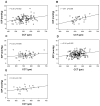Intraocular pressure and central corneal thickness in the COMET cohort
- PMID: 22820476
- PMCID: PMC3726188
- DOI: 10.1097/OPX.0b013e3182639fc7
Intraocular pressure and central corneal thickness in the COMET cohort
Abstract
Purpose: To describe intraocular pressure (IOP) and central corneal thickness (CCT) in ethnically diverse, myopic young adults enrolled in COMET (the Correction of Myopia Evaluation Trial) and their association with ocular and demographic factors.
Methods: IOP (Goldmann tonometry), CCT (handheld pachymetry), refractive error (cycloplegic autorefraction), and ocular components (A-scan ultrasonography) were measured in 385 of the original 469 subjects (mean age = 20.3 ± 1.3 years). Summary statistics for descriptive analysis, Pearson correlation coefficients, and linear regression models to formally test the association of IOP and CCT with other covariates were used.
Results: Mean IOP was 15.1 ± 0.1 mm Hg and differed by ethnicity and CCT but did not vary by gender, magnitude of myopia, or vitreous chamber depth (VCD). Adjusting for CCT, IOP in black participants was 1.8 mm Hg higher than in Hispanics (p = 0.0001) and 0.8 mm Hg higher than in whites (p = 0.03). Mean CCT was 562.4 ± 1.8 μm and differed by ethnicity, VCD, and IOP after adjusting for covariates. Blacks had thinner corneas than Asians, whites, and Hispanics, with adjusted differences of 15.4, 11.8, and 15.3 μm (p = 0.03, < 0.01 and < 0.01), respectively. Eyes with shorter VCD (<17.8 mm) had 8.0-μm thinner CCT (p = 0.03). CCT did not vary by gender or magnitude of myopia. Overall, a modest positive correlation (r = 0.25, P < 0.0001) was found between IOP and CCT, which varied by ethnicity in Asians (r = 0.47; p = 0.008), blacks (r = 0.29; p = 0.002), and whites (r = 0.24; p = 0.002).
Conclusions: Myopic, black young adults had higher IOP and thinner corneas relative to other ethnic groups, suggesting that evaluation of these parameters during routine examination of these individuals should begin at a young age. Their thinner CCT should also be considered in evaluations for refractive surgery.
Figures
References
-
- Gwiazda J, Hyman L, Hussein M, Everett D, Norton TT, Kurtz D, Leske MC, Manny R, Marsh-Tootle W, Scheiman M. A randomized clinical trial of progressive addition lenses versus single vision lenses on the progression of myopia in children. Invest Ophthalmol Vis Sci. 2003;44:1492–500. - PubMed
-
- Friedman B. Stress upon the ocular coats: effects of scleral curvature, scleral thickness, and intra-ocular pressure. Eye Ear Nose Throat Mon. 1966;45:59–66. - PubMed
-
- Pruett RC. Progressive myopia and intraocular pressure: what is the linkage? A literature review Acta. Ophthalmol Suppl. 1988;185:117–27. - PubMed
-
- Tokoro T, Funata M, Akazawa Y. Influence of intraocular pressure on axial elongation. J Ocul Pharmacol. 1990;6:285–91. - PubMed
-
- Quinn GE, Berlin JA, Young TL, Ziylan S, Stone RA. Association of intraocular pressure and myopia in children. Ophthalmology. 1995;102:180–5. - PubMed
Publication types
MeSH terms
Grants and funding
LinkOut - more resources
Full Text Sources
Medical



